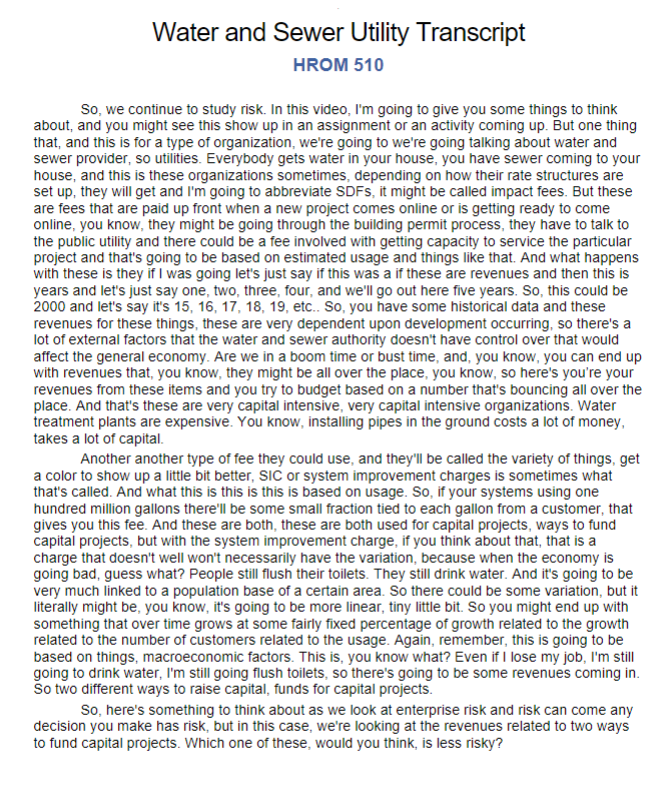Answered step by step
Verified Expert Solution
Question
1 Approved Answer
Water and Sewer Utility Transcript HROM 510 So, we continue to study risk. In this video, I'm going to give you some things to

Water and Sewer Utility Transcript HROM 510 So, we continue to study risk. In this video, I'm going to give you some things to think about, and you might see this show up in an assignment or an activity coming up. But one thing that, and this is for a type of organization, we're going to we're going talking about water and sewer provider, so utilities. Everybody gets water in your house, you have sewer coming to your house, and this is these organizations sometimes, depending on how their rate structures are set up, they will get and I'm going to abbreviate SDFS, it might be called impact fees. But these are fees that are paid up front when a new project comes online or is getting ready to come online, you know, they might be going through the building permit process, they have to talk to the public utility and there could be a fee involved with getting capacity to service the particular project and that's going to be based on estimated usage and things like that. And what happens with these is they if I was going let's just say if this was a if these are revenues and then this is years and let's just say one, two, three, four, and we'll go out here five years. So, this could be 2000 and let's say it's 15, 16, 17, 18, 19, etc.. So, you have some historical data and these revenues for these things, these are very dependent upon development occurring, so there's a lot of external factors that the water and sewer authority doesn't have control over that would affect the general economy. Are we in a boom time or bust time, and, you know, you can end up with revenues that, you know, they might be all over the place, you know, so here's you're your revenues from these items and you try to budget based on a number that's bouncing all over the place. And that's these are very capital intensive, very capital intensive organizations. Water treatment plants are expensive. You know, installing pipes in the ground costs a lot of money, takes a lot of capital. Another another type of fee they could use, and they'll be called the variety of things, get a color to show up a little bit better, SIC or system improvement charges is sometimes what that's called. And what this is this is this is based on usage. So, if your systems using one hundred million gallons there'll be some small fraction tied to each gallon from a customer, that gives you this fee. And these are both, these are both used for capital projects, ways to fund capital projects, but with the system improvement charge, if you think about that, that is a charge that doesn't well won't necessarily have the variation, because when the economy is going bad, guess what? People still flush their toilets. They still drink water. And it's going to be very much linked to a population base of a certain area. So there could be some variation, but it literally might be, you know, it's going to be more linear, tiny little bit. So you might end up with something that over time grows at some fairly fixed percentage of growth related to the growth related to the number of customers related to the usage. Again, remember, this is going to be based on things, macroeconomic factors. This is, you know what? Even if I lose my job, I'm still going to drink water, I'm still going flush toilets, so there's going to be some revenues coming in. So two different ways to raise capital, funds for capital projects. So, here's something to think about as we look at enterprise risk and risk can come any decision you make has risk, but in this case, we're looking at the revenues related to two ways to fund capital projects. Which one of these, would you think, is less risky?
Step by Step Solution
There are 3 Steps involved in it
Step: 1
Based on the information provided in the transcript the system improvement charges SIC would be cons...
Get Instant Access to Expert-Tailored Solutions
See step-by-step solutions with expert insights and AI powered tools for academic success
Step: 2

Step: 3

Ace Your Homework with AI
Get the answers you need in no time with our AI-driven, step-by-step assistance
Get Started


